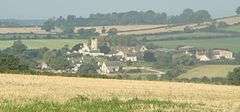Stanton Prior
| Stanton Prior | |
 View of Stanton Prior village, August 2007 |
|
 Stanton Prior |
|
| OS grid reference | ST675628 |
|---|---|
| Civil parish | Marksbury |
| District | Bath & North East Somerset |
| Shire county | Somerset |
| Region | South West |
| Country | England |
| Sovereign state | United Kingdom |
| Post town | BATH |
| Postcode district | BA2 |
| Dialling code | 01761 |
| Police | Avon and Somerset |
| Fire | Devon and Somerset |
| Ambulance | South Western |
| EU Parliament | South West England |
| UK Parliament | North East Somerset |
Coordinates: 51°21′52″N 2°27′48″W / 51.3644°N 2.4633°W
Stanton Prior is a small village, within the civil parish of Marksbury, set in Duchy of Cornwall countryside, 6 miles (9.7 km) south west from the UK city of Bath, Somerset.
Stanton Prior derives its name from the Old English 'Stantona'[1] (meaning Stone Town) and is reputed to be one of the smallest villages in Somerset,[2] consisting of two farms, 21 houses and the Church of St Lawrence, which has its origins in the 12th century but is mainly 15th century and underwent heavy restoration in 1860. The church has been designated by English Heritage as a Grade II* listed building.[3]
The village was the property of Saxon Kings who gave it to Bath Abbey before the Norman Conquest and it was help by the Prior until the dissolution of the monasteries. It was then granted to Thomas Horner, who sold it to General Erington in 1544.[4] The parish of Stanton Prior was part of the Keynsham Hundred,[5]
Close by, on Stantonbury Hill, are the remains of an Iron Age hill fort known as Stantonbury Camp,[6] which lies on the line of Wansdyke.[7] Stanton is home to a rare chain pump, albeit without its chain.[8]
The village is one of Somerset's eight Thankful Villages (from a total of 32 villages in England),[9] in which all the men who served in World War I came home. The other seven were Aisholt, Chantry, Chelwood, Rodney Stoke, Stocklinch, Tellisford and Woolley.
Church Farm in Stanton Prior is farmed organically, using crop rotation, and was awarded the 2005 Silver certificate in the Habitat Award Scheme run by the Duchy of Cornwall. The lack of herbicides has allowed considerable plant diversity with a range of Countryside Stewardship options. A target is to establish a covey of grey partridge on the farm.[10]
References
- ↑ Notes and Queries, s6-IX: 101-120 (1884) Oxford Journals
- ↑ "Population Profile of Somerset 1961". Retrieved 2007-09-22.
- ↑ "Church of St Lawrence". Images of England. Retrieved 2007-09-22.
- ↑ Robinson, W.J. (1915). West Country Churches. Bristol: Bristol Times and Mirror Ltd. pp. 169–173.
- ↑ "Somerset Hundreds". GENUKI. Retrieved 15 October 2011.
- ↑ "Stantonbury Hill". Retrieved 2007-09-22.
- ↑ "Stanton Prior". British History Online. Retrieved 2007-09-22.
- ↑ http://www.villagepumps.org.uk/pumpsSoms.htm
- ↑ Arthur Mee, Somerset, Hodder and Stoughton (1941)
- ↑ "Duke of Cornwall's Habitat Award". Duchy of Cornwall. Retrieved 2007-09-22.
External links
| Wikimedia Commons has media related to Stanton Prior. |